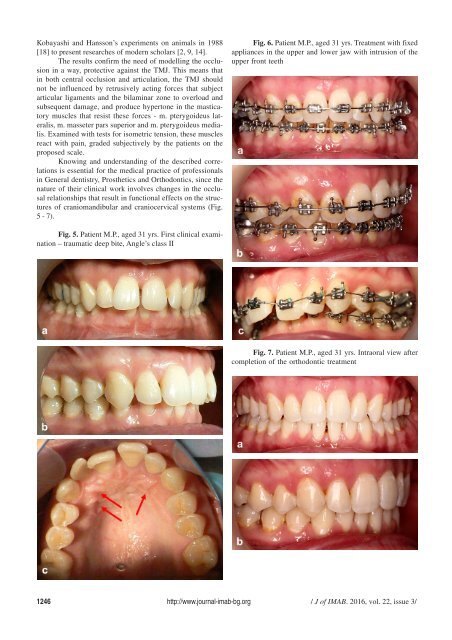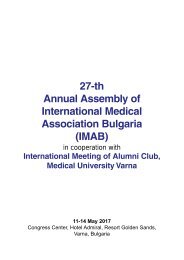JofIMAB-2016-vol22-issue3
You also want an ePaper? Increase the reach of your titles
YUMPU automatically turns print PDFs into web optimized ePapers that Google loves.
Kobayashi and Hansson’s experiments on animals in 1988<br />
[18] to present researches of modern scholars [2, 9, 14].<br />
The results confirm the need of modelling the occlusion<br />
in a way, protective against the TMJ. This means that<br />
in both central occlusion and articulation, the TMJ should<br />
not be influenced by retrusively acting forces that subject<br />
articular ligaments and the bilaminar zone to overload and<br />
subsequent damage, and produce hypertone in the masticatory<br />
muscles that resist these forces - m. pterygoideus lateralis,<br />
m. masseter pars superior and m. pterygoideus medialis.<br />
Examined with tests for isometric tension, these muscles<br />
react with pain, graded subjectively by the patients on the<br />
proposed scale.<br />
Knowing and understanding of the described correlations<br />
is essential for the medical practice of professionals<br />
in General dentistry, Prosthetics and Orthodontics, since the<br />
nature of their clinical work involves changes in the occlusal<br />
relationships that result in functional effects on the structures<br />
of craniomandibular and craniocervical systems (Fig.<br />
5 - 7).<br />
Fig. 6. Patient M.P., aged 31 yrs. Treatment with fixed<br />
appliances in the upper and lower jaw with intrusion of the<br />
upper front teeth<br />
Fig. 5. Patient M.P., aged 31 yrs. First clinical examination<br />
– traumatic deep bite, Angle’s class II<br />
Fig. 7. Patient M.P., aged 31 yrs. Intraoral view after<br />
completion of the orthodontic treatment<br />
1246 http://www.journal-imab-bg.org / J of IMAB. <strong>2016</strong>, vol. 22, issue 3/



